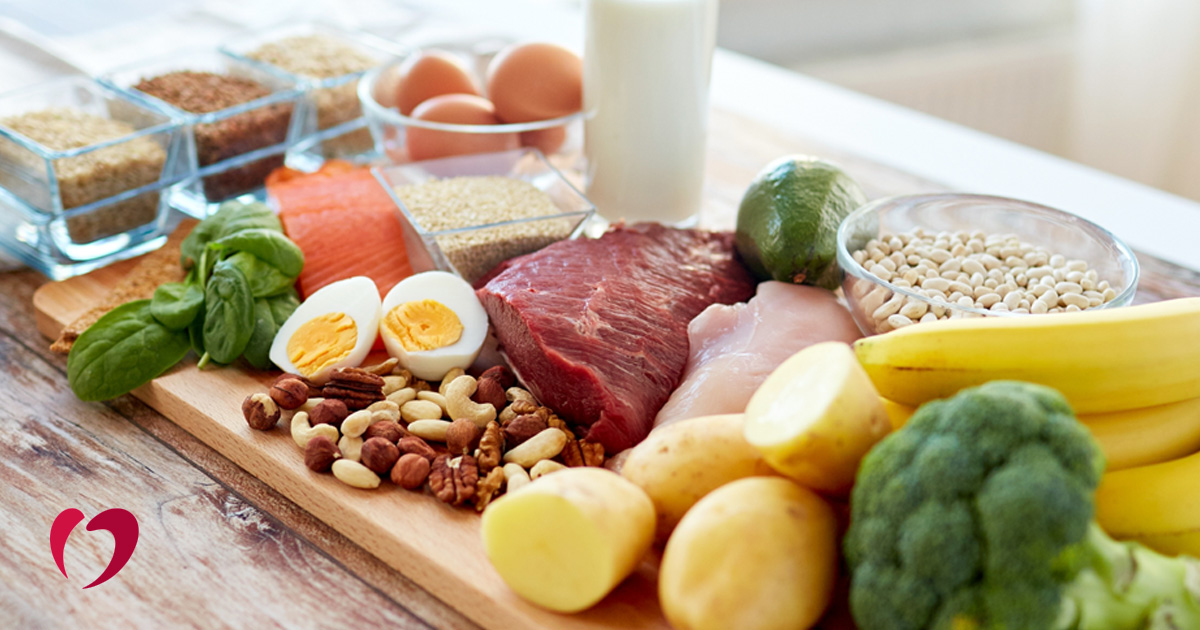The Keys to a Balanced Diet

Wander down the center aisle of any grocery store, and you’ll be amazed at the number of number of claims on the front of those boxes. Now with 50% less fat! Reduced sugar! Low sodium! Sometimes those claims can be helpful, but it’s important to understand the role the carbohydrates (which includes sugar), protein, fat, and sodium play in overall nutrition.
Carbohydrates
Most people have heard the terms “good carbs” and “bad carbs,” but another way to categorize them is “slow carbs” and “fast carbs.” Fast carbs are refined carbohydrates that can be found in processed foods, sugary drinks, white rice, and white bread. Fast carbs will quickly spike your blood sugar, which is followed by a rapid drop in blood sugar. Most fast carbs only stay with you for 15 to 30 minutes, and then you’re likely to be hungry again. Slow carbs, on the other hand, keep your blood sugar relatively level for a longer period of time since it takes your body longer to break down the slow-acting carbohydrates. Slow carbs can be found in whole grains and high fiber foods, such as brown rice, beans, or whole grain bread with 3 g of fiber or more per slice.
If your current eating habits include a lot of fast carbs, look for options to swap slower carbs in their place. Instead of mashed potatoes, try roasted and mashed cauliflower. Swap white bread for a 100% whole grain bread with at least 3 grams of fiber per slice. To reduce sugar intake, try swapping your regular can of soda for a glass of fruit-infused water instead.
Protein
Protein helps stabilize blood sugar over a longer period of time than even most slow acting carbohydrates, because it takes longer for the body to break down and use protein. Good sources of protein include skinless poultry, fish, and very lean, trimmed meats. Eggs and low-fat dairy, such as skim to 1% milk and nonfat Greek yogurt (ideally plain, but if choosing a flavored yogurt, watch the sugar content) can also be a good source of protein.
If your current protein sources are mostly red meat, consider swapping for skinless poultry or fish once or twice a week to start. Switching to leaner protein sources can help reduce your overall calorie intake and reduce the amount of saturated fat in your day.
Fat
Fat is an important part of an overall balanced diet, but there are good and bad sources of fat. Small portions of plant-based fats, such as nuts and olive oil, are best to add to your diet. But even with good fats, it’s important to remember that fats are calorie dense and should be eaten in moderation.
Saturated fats are typically found in animal products, such as butter, whole milk, chicken skin, and fatty meats. Partially hydrogenated or trans fats are often processed fats like shortening and stick margarine, which can actually raise your LDL (bad cholesterol) and lower your protective HDL (good cholesterol). A balanced diet should limit saturated fats and avoid trans fats as much as possible and focus on small amounts of healthy, plant-based fats.
Sodium
Sodium is another area where most people far exceed the recommended daily allowance, especially if you eat out or eat any processed foods. Salt is in almost everything, and it doesn’t take much to exceed the daily allowance. People with high blood pressure and other heart health issues need to be especially aware of limiting their daily salt intake. The American Heart Association recommends no more than 2300 mg per day of sodium, but the ideal limit is no more than 1500 mg per day. Just one-quarter teaspoon of salt contains about 600 mg of sodium. Some restaurant entrees can contain 4,000 mg or more of sodium! And when reading nutrition labels, it’s important to look at the serving size, since even an average can of soup may contain 2.5 servings. At 800 mg of sodium per serving, one can of soup quickly puts you close to the daily limit in just one meal.
Sodium can also impact weight loss, since high sodium intake can result in fluid retention. To reduce sodium, prepare more fresh foods at home and use herb and spice seasonings to add flavor without added salt. Look specifically for salt-free seasoning blends or use individual herbs and spices, as many pre-made seasoning blends contain high levels of salt. Some brands now offer salt-free seasoning packets for tacos and chili.
As you embrace healthier eating, try to plan ahead as much as possible be preparing meals and snacks in advance to help maintain balance through the day. If you’re eating out, don’t be shy about requesting substitutions or off-menu options. For example, order a double serving of non-starchy vegetables and request that no additional fat or salt be added during cooking. You can also look up nutrition information for many restaurants online, which may help you make a healthier choice on where to eat or what to order.
Trying to eat better for weight loss or heart health? Oklahoma Heart Hospital’s nutritionists help patients plan for dietary changes to improve their health. Contact us today for more information.
